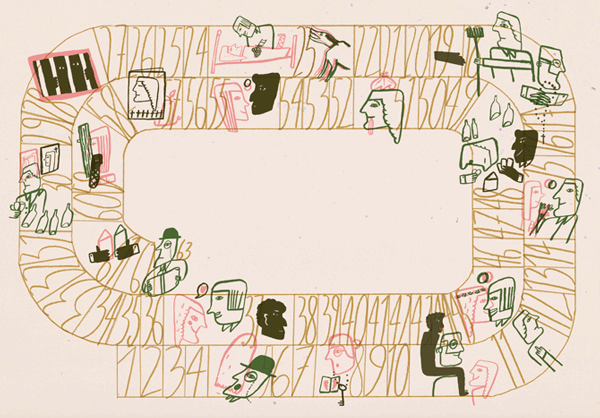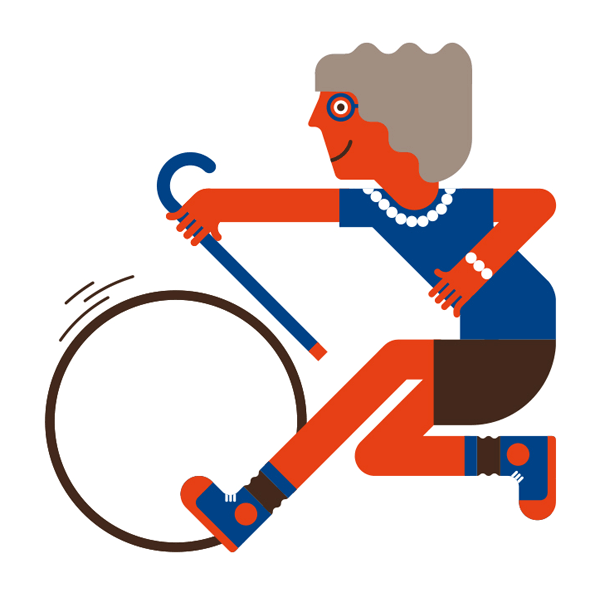Belgian illustrator Sarah Vanbelle likes simple forms and not too many colours. Her work was featured in Knack magazine and The Wall Street Journal, among others.

Please tell us something about your background.
As a child in Zandhoven, a small town outside Antwerp, I was always reading and drawing. There would be paint and pens and paper all over the house. My grandfather had wanted to become an artist. He owned a lot of art books, and he would always encourage us to express ourselves in an artistic way. My brother and sister are creative people as well. My brother is studying to be an architect and my sister, who suffers from autism, loves to draw.
I studied languages in high school, but I already spent a lot of time designing invitations and birthday cards on the computer. At the time I was determined to study graphic design at Sint-Lucas in Antwerp, but I changed my mind after attending an open day there. I took a look at the illustration department, and I loved what I saw. We were expected to make our own images, to tell stories, to work with our hands. We were taught how to print our own work. It was a big change from high school. I loved every single minute.
My first commission after graduating came from Tim Oeyen, who at the time was an art director at Knack Weekend magazine. He had also tutored my graduation project. I did a series of drawings for the magazine’s horoscope section. Around the same time, I decided to study interior design at Eindhoven’s Design Academy. Contrary to my expectations, this was something of a disappointing experience. When you design a space, every aspect has to work. A drawing is less complicated: it has to work on its own, there is no functionality involved. In truth, I found the course boring, and I quit after a few months. I began working on Knack Weekend’s layout team and set out on my career as a freelance illustrator.
What inspires you?
Beautiful exhibitions and travelling, I enjoy Matisse. I like to look at the work of Enzo Mari and Bruno Munari. Dick Bruna is really interesting to me, as is David Hockney. What I like about Munari is how he deconstructs books, for instance in using a book’s paper as part of its design.
Please introduce us to a few of your projects.
I designed a stain-glassed window for Leuven University. Unfortunately, the project never came about, but it’s something I was really excited about: a huge piece, with light shining through it. It would have been interesting to learn the technique. What colours to choose, how to cut the glass.
I used to illustrate a weekly column in Knack Focus, the entertainment weekly. There was never a lot of time, more often than not I had half a day to come up with a drawing. One week the piece would be about Scandinavian thrillers, the other week it would be something to do with Shakespeare. I enjoyed working that fast.
Last year, I was part of Pick me up, an exhibition in London featuring 17 young illustrators. We each were given part of a wall to use as we saw fit.
I designed a kind of apartment with windows that you could look through, and you’d discover all kinds of illustrations. It’s quite an experience to be working on such a project by yourself in your studio and then seeing it exposed for a great number of people. In a way, that stressed me out, but it was really cool at the same time.
And lastly, there was a series of posters for newcomers in Antwerp, introducing them to local associations. This was a great project for me because I could combine illustration and graphic design, and it’s always nice when you able to do both.
How would you describe your own style?
A style is about form, not about words. I find it hard to describe my style. I like simple forms and good compositions. Strong colours, but not too many. And hopefully, I have a good idea from time to time.
Would you say that there is a Belgian school of illustration, and if so, do you consider yourself part of it?
There are a lot of illustrators in Antwerp, where I am based. And we do a lot of things together, and I enjoy that. But I wouldn’t say that we have a common, Belgian style. Ultimately, you are working on your own.
Then there is Belgium’s comic strip tradition.
When I think about Belgian comics, I think about the ‘klare lijn’ (Hergés’ ligne claire style, ed), and it just happens that I don’t use many lines. I loved reading comics when I was younger, but an illustrator like Dick Bruna (the Dutch illustrator of Miffy, ed) is a much more obvious influence.
In your view, what are the biggest challenges for a freelance illustrator?
The short deadlines. And there is no job security, no clear structure. You have to figure out everything by yourself. And you also need to make sure that you don’t spend too much time behind your computer, that you make time to see friends, stuff like that.
Work wise, you’re often expected to do something you already master. You’re supposed to repeat yourself. That’s why I find it important to keep doing personal work, to discover new things. I would like to do animation at some point. I would love to do a book. I’m not the best storyteller so I might have to borrow someone else’s story.
How do you see your future?
I will be working two days a week at Knack magazine shortly, to design infographics. We’ll see how it works out, but it’s an exciting opportunity. With infographics, the challenge is to explain complex issues in a simple way. I think that my style is well suited for that kind of work. Ideally, you end up with a beautiful combination of graphic design and illustration.


